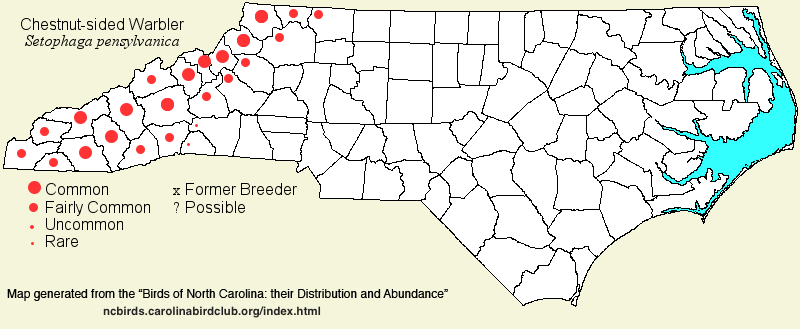 |  |
|
Chestnut-sided Warbler - Setophaga pensylvanica PARULIDAE Members: | Search Common: Search Scientific: |
|
|
|||||||
| General Comments | The Chestnut-sided Warbler breeds in southern Canada and the northeastern part of the United States, extending down the Appalachians into Georgia. In the early decades of the 20th Century, this was a scarce breeding bird in the North Carolina mountains; however, maybe owing to extensive fires and logging in the 1930's and 1940's (if not earlier), large amounts of early succession habitat was available for this species. Numbers have leveled off since the latter few decades of the last century, but since then, this has been one of the most common of all birds nesting in the province. Breeding habitat is wooded edges, regenerating clearcuts, forest openings, and other early to mid-succession forested areas, mainly in deciduous saplings and trees. Downstate, it migrates mainly through the Piedmont, and it can be a good find in the Coastal Plain, even in fall. | ||||||
| Breeding Status | Breeder | ||||||
| NC BRC List | Definitive | ||||||
| State Status | |||||||
| U.S. Status | |||||||
| State Rank | S5B | ||||||
| Global Rank | G5 | ||||||
| Coastal Plain | Transient. Very rare in spring over most of the province, more likely to occur in the western sections, and again near and along the coast; casual in much of the central and eastern portions. In fall, rare to uncommon over most of the region, and rare in the eastern section, even along the coast. Mainly most of May, and late Aug to early Oct. Peak counts: | ||||||
| Piedmont | Transient. In spring, uncommon in the western half of the region, and rare to uncommon in the eastern half. In fall, generally uncommon throughout; more numerous in the province than in spring nearly everywhere. Accidental in winter, with one record -- a bird photographed in Chatham on 21 Dec 2014 [Chat 79:104-105 link]. Quite surprising was at least one male singing on territory at Chimney Rock Park (Rutherford) in 1990, 1992, and 1993; no conclusive breeding was reported. Mainly very late Apr to mid-May, and late Aug to early Oct. Peak counts: | ||||||
| Mountains | Summer resident. Common to very common from about 3,000 feet to 5,500 feet; uncommon higher and lower, down to about 2,000 feet in local areas. Can be common in migration, especially in fall. Mainly from late Apr to early Oct. Peak counts: | ||||||
| Finding Tips |
Normally easily found in the mountains in May and Jun, particularly between 3,500 and 5,000 feet. **** | ||||||
| Attribution | LeGrand[2023-04-08], LeGrand[2015-08-23], LeGrand[2013-12-13] | ||||||
| NC Map Map depicts all counties with a report (transient or resident) for the species. | Click on county for list of all known species. |
| NC Breeding Season Map Map depicts assumed breeding season abundance for the species. |  |